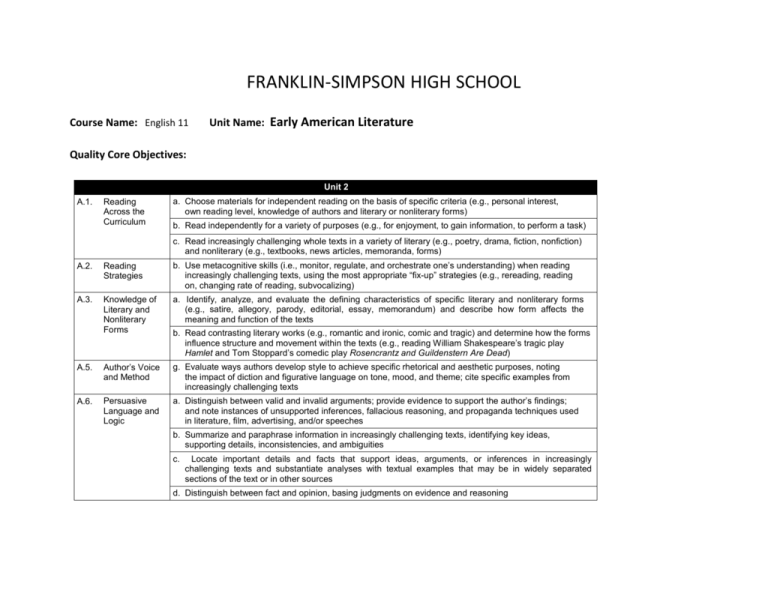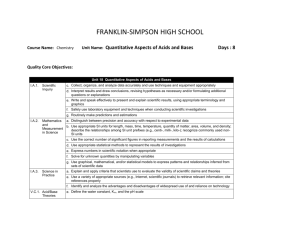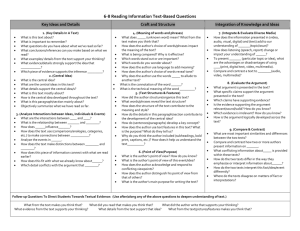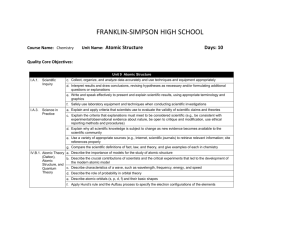Unit 2 - Simpson County Schools
advertisement

FRANKLIN-SIMPSON HIGH SCHOOL Course Name: English 11 Unit Name: Early American Literature Quality Core Objectives: Unit 2 A.1. Reading Across the Curriculum a. Choose materials for independent reading on the basis of specific criteria (e.g., personal interest, own reading level, knowledge of authors and literary or nonliterary forms) b. Read independently for a variety of purposes (e.g., for enjoyment, to gain information, to perform a task) c. Read increasingly challenging whole texts in a variety of literary (e.g., poetry, drama, fiction, nonfiction) and nonliterary (e.g., textbooks, news articles, memoranda, forms) A.2. Reading Strategies b. Use metacognitive skills (i.e., monitor, regulate, and orchestrate one’s understanding) when reading increasingly challenging texts, using the most appropriate “fix-up” strategies (e.g., rereading, reading on, changing rate of reading, subvocalizing) A.3. Knowledge of Literary and Nonliterary Forms a. Identify, analyze, and evaluate the defining characteristics of specific literary and nonliterary forms (e.g., satire, allegory, parody, editorial, essay, memorandum) and describe how form affects the meaning and function of the texts A.5. Author’s Voice and Method g. Evaluate ways authors develop style to achieve specific rhetorical and aesthetic purposes, noting the impact of diction and figurative language on tone, mood, and theme; cite specific examples from increasingly challenging texts A.6. Persuasive Language and Logic a. Distinguish between valid and invalid arguments; provide evidence to support the author’s findings; and note instances of unsupported inferences, fallacious reasoning, and propaganda techniques used in literature, film, advertising, and/or speeches b. Read contrasting literary works (e.g., romantic and ironic, comic and tragic) and determine how the forms influence structure and movement within the texts (e.g., reading William Shakespeare’s tragic play Hamlet and Tom Stoppard’s comedic play Rosencrantz and Guildenstern Are Dead) b. Summarize and paraphrase information in increasingly challenging texts, identifying key ideas, supporting details, inconsistencies, and ambiguities c. Locate important details and facts that support ideas, arguments, or inferences in increasingly challenging texts and substantiate analyses with textual examples that may be in widely separated sections of the text or in other sources d. Distinguish between fact and opinion, basing judgments on evidence and reasoning A.8. Words and Their History a. Apply knowledge of Greek, Latin, and Anglo-Saxon affixes, inflections, and roots to understand unfamiliar words and new subject matter vocabulary in increasingly challenging texts (e.g., words in science, mathematics, and social studies) b. Infer word meanings by analyzing relationships between words (e.g., synonyms, antonyms, metaphors, analogies) in increasingly challenging texts c. Use general and specialized dictionaries, thesauruses, and glossaries (print and electronic) to determine the definition, pronunciation, derivation, spelling, and usage of words g. Describe and provide examples of the ways past and present events (e.g., cultural, political, technological, scientific) have influenced the English language B.1. Writing Process b. Analyze writing assignments in terms of purpose and audience to determine which strategies to use (e.g., writing a speech to inform versus a speech to persuade) D.1. Comprehension b. Identify and evaluate the effect of logical fallacies (e.g., overgeneralization, bandwagon) and the presence of biases and stereotypes in television and print advertising, speeches, newspaper articles, and and Analysis Internet advertisements c. Analyze the effectiveness and validity of arguments (e.g., causation, analogy, inductive and deductive reasoning, appeals to emotion or authority) in visual and oral texts e. Analyze and evaluate the way language choice (e.g., repetition, use of rhetorical questions) and delivery style (e.g., eye contact, nonverbal messages) affect the mood and tone of the communication and make an impact on the audience Purpose of the Unit: Take rhetorical analysis devices and begin applying those devices to argument analysis through the study of early American literature Prerequisites: Rhetorical devices/skills of coordination, Ethos/Pathos/Logo, shift, syntax, extended metaphor, repetition, allusion, juxtaposition, and thesis construction Daily Lesson Guide Day Lesson Content and Daily Focus Questions 1 “All I Ever Needed to Know I Learned in Kindergarten” Poor Richards Almanac Identify the structure of an argument based on West’s Advancing Composition and Aristotle’s Triangle Classify excerpts from Fulgam’s “All I Ever Really Needed to Know I Learned in Kindergarten” and excerpts from Franklin’s “Poor Richard’s Almanac” in terms of argument structures Analysis of “The Speech of Miss Polly Baker” Analysis of Franklin’s “The Speech of Miss Polly Baker” in terms of the structure of an argument as well as rhetorical devices 2 Tasks/Procedures Knowledge and Critical Thinking Comprehension (High Yield / Literacy /LTF/etc.) Activities Vocabulary/ACT-like Bell Ringer Modeled Practice Think, Pair, Share Engagement Personal response Emotional/ intellectual safety Learning with others Assessment and/or Accommodations Exit slip which categorizes a quotation using a current vocabulary word and rhetorical device AP Accommodation: Exit slip which categorizes a quotation using 2 current vocabulary words and 2rhetorical devices Special Education Accommodations: Reader, paraphrasing, prompting and cueing, manipulatives, use of technology Vocabulary/ACT-like Bell Ringer Annotation Modeled Practice Clear modeled expectations Personal response Emotional/ intellectual safety AP Accommodation: Juxtaposition of “The Speech of Miss Polly Baker” with Sojourner Truth’s “Aren’t I a Woman?” Special Education Accommodations: Reader, paraphrasing, prompting and cueing, manipulatives, use of technology 3 4 Revolutionary visual texts Evidence Video –Legally Blonde Analysis of revolutionary war visual texts in context of the tone of the time and the rhetorical devices associated with argument Lou Gehrig to Patrick Henry Speeches Appraise the speeches of Lou Gehrig to Patrick Henry for argumentation style Vocabulary/ACT-like Bell Ringer Discussion Visual text analysis Vocabulary/ACT-like Bell Ringer Discussion Annotation Modeled Practice Comparative analysis 5 Lou Gehrig to Patrick Henry Speeches Appraise the speeches of Lou Gehrig to Patrick Henry for argumentation style Vocabulary/ACT-like Bell Ringer Annotation Thesis/Conclusion Work 6 Moving Visual Text: 1776 and summative Vocabulary Assessment Units 1-3 Analyze visual text of 1776 for rhetorical devices associated with argument Visual text analysis Clear modeled expectations Personal response Emotional/ intellectual safety Special Education Accommodations: Prompting and cueing, paraphrasing, graphic organizer, reader, manipulatives, use of technology AP Accommodation: enrichment of other texts and difficulty of analysis/argument Clear modeled expectations Personal response Emotional/ intellectual safety Special Education Accommodations: Prompting and cueing, paraphrasing, graphic organizer, reader, manipulatives, use of technology AP Accommodation: enrichment of other texts and difficulty of analysis/argument Clear modeled expectations Personal response Emotional/ intellectual safety Special Education Accommodations: Prompting and cueing, paraphrasing, graphic organizer, reader, manipulatives, use of technology AP Accommodation: enrichment of other texts and difficulty of analysis/argument Clear modeled expectations Personal response Emotional/ intellectual Unit Assessment Vocabulary Special Education Accommodations: Reader, paraphrasing, prompting and cueing, modified assignment, extended time (time and ½), chunking, manipulatives, use of 7 Letters of Abigail Adams Evaluate the American Revolution from the female persona Vocabulary/ACT-like Bell Ringer Annotation Connecting editorial article 8 Independence Day lyrics Synthesize rhetorical analysis/argument/vocabulary with a visual text Vocabulary/ACT-like Bell Ringer Reading non-fiction text of choice for file archive Annotation Modeled Practice Graphic organizer 9 Declaration of Independence Connect the Declaration of Independence to the Declaration of the Rights of Women Vocabulary/ACT-like Bell Ringer Discussion Comparative writing – juxtaposition of texts 10 King George and Queen Elizabeth I Examine King George and Queen Elizabeth I arguments in the context of refutation Vocabulary/ACT-like Bell Ringer Annotation safety technology Clear modeled expectations Personal response Emotional/ intellectual safety Special Education Accommodations: Prompting and cueing, paraphrasing, graphic organizer, reader, manipulatives, use of technology AP Accommodation: enrichment of other texts and difficulty of analysis/argument Clear modeled expectations Personal response Emotional/ intellectual safety Special Education Accommodations: Prompting and cueing, paraphrasing, graphic organizer, reader, manipulatives, use of technology AP Accommodation: enrichment of other texts and difficulty of analysis/argument Personal response Emotional/ intellectual safety Clear modeled expectations Sense of audience Special Education Accommodations: Reader, paraphrasing, prompting and cueing, manipulatives, use of technology AP Accommodation: enrichment of other texts and difficulty of analysis/argument Clear modeled expectations Personal response Special Education Accommodations: Prompting and cueing, paraphrasing, graphic organizer, reader, manipulatives, use of 11 Courtesy of the Red, White, and Blue lyrics coupled with political cartoons Interupt lyrical and visual th representations of the 18 to st the 21 century American Ideals The Devil and Tom Walker Evaluate characteristics of a short story in terms of rhetorical devices associated with Romanticism Vocabulary/ACT-like Bell Ringer Annotation Modeled Practice Editorial Cartoon Sheet Emotional/ intellectual safety technology AP Accommodation: enrichment of other texts and difficulty of analysis/argument Clear modeled expectations Personal response Emotional/ intellectual safety Special Education Accommodations: Prompting and cueing, paraphrasing, graphic organizer, reader, manipulatives, use of technology AP Accommodation: enrichment of other texts and difficulty of analysis/argument Clear modeled expectations Personal response Emotional/ intellectual safety Special Education Accommodations: Prompting and cueing, paraphrasing, graphic organizer, reader, manipulatives, use of technology AP Accommodation: enrichment of other texts and difficulty of analysis/argument Clear modeled expectations Personal response Emotional/ intellectual safety Special Education Accommodations: Prompting and cueing, paraphrasing, graphic organizer, reader, manipulatives, use of technology AP Accommodation: enrichment of other texts and difficulty of analysis/argument Personal response Emotional/ intellectual safety Special Education Accommodations: Prompting and cueing, paraphrasing, graphic organizer, reader, manipulatives, use of Vocabulary/ACT-like Bell Ringer Graphic Organizer 12 13 The Devil and Tom Walker Evaluate characteristics of a short story in terms of rhetorical devices associated with Romanticism Vocabulary/ACT-like Bell Ringer Graphic Organizer Review for Unit test 14 Unit Test 15 Clear modeled expectations Sense of audience technology AP Accommodation: enrichment of other texts and difficulty of analysis/argument Personal response Emotional/ intellectual safety Clear modeled expectations Sense of audience Unit Assessment Special Education Accommodations: Reader, paraphrasing, prompting and cueing, modified assignment, extended time (time and ½), chunking, manipulatives, use of technology AP Accommodation: enrichment of other texts and difficulty of analysis/argument







